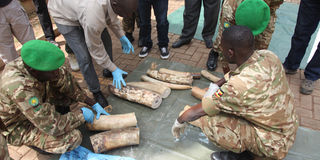Uganda’s struggle to tame poaching during lockdown

What you need to know:
A Uganda Wildlife Trafficking Assessment report released in 2018, identified Uganda as one of the commonest transits of wildlife products in the Central and East African region
Wildlife poaching in Uganda has risen during the Covid-19 induced lockdown, but authorities say they are working hard to stop the vice that is costing the country in both tourism revenues and illicit financial flows.
A Uganda Wildlife Trafficking Assessment report released in 2018, identified Uganda as one of the commonest transits of wildlife products in the Central and East African region.
The report also reveals that wildlife trafficking is aided by unlicensed markets in DR Congo, Cameroon, Chad, Central African Republic, and corrupt officials.
The Uganda Wildlife Authority (UWA) commissioner for conservation, Mr John Makombo, says between February and June, 367 cases of poaching were recorded across the country.
This, he says, is higher than 163 cases recorded during the same period last year.
The most recent case is of Rafiki, a beloved silverback gorilla that was killed in Bwindi Impenetrable National Park in South Western Uganda in June.
In a recent interview with Saturday Monitor, Mr Sam Mwandha, the UWA executive director, confirmed that Rafiki’s killer was sentenced to 11 years in prison.
Mr Mwandha reveals that the authorities are determined to ensure all poachers and those caught in the act are taken to courts of law for prosecution.
Meanwhile, Mr Bashir Hangi, the corporate communications manager at UWA, says poaching cases could have worsened if there were no game rangers on ground.
“We knew poachers would take advantage of the lockdown to invade our national parks and that’s why we managed to capture that number. They (poachers) found our rangers readily waiting for them,” he said.
The Annual Tourism Sector Performance report for the Financial Year 2018/2019, indicates that tourism revenue increased from $1.4b (about Shs5.3 trillion) in the 2017/2018 financial year to $1.6b (about Shs5.8 trillion) in the 2018/2019 financial year.
Contribution to GDP
Basing on the above statistics, the report states that the tourism sector had contributed more than 7.7 per cent to Uganda’s Gross Domestic Product, as well as up to 6.7 per cent of the total national employment after creating 667,600 indirect and direct jobs.
According to a 2017 report by Royal United Services Institute (RUSI), a London and Nairobi-based think-tank, all over the world, for every animal or plant specimen taken illegally from the wild, money changes hands.
RUSI, which helps build capacity in detecting and prosecuting wildlife-linked money-laundering across East Africa, also states that wildlife crime is not simply a crime against wildlife, but it is organised financial crime conducted on an industrial and transnational scale for profit.
Data obtained from the Uganda Conservation Foundation website reveals that Illegal Wildlife Trade (IWT) is the fourth-largest illicit activity worldwide, generating $7m (about Shs26.2b) per year.
The foundation states that although little is known about these illicit money flows in source and transit areas such as Uganda, a lot of factors come into play.
“Lack of political will, lack of transparency, the dependence of Africa on natural resource extraction—a particularly vulnerable loophole for Illicit Financial Flows (IFF), corruption, weak national and regional capacities, all these impede efforts to curb IFF,” states the foundation on its website.
Data obtained from Natural Resource Conservation Network (NRCN), an organisation dealing in conservation of wildlife in Uganda, indicates that the country loses at least $ 5m (about Shs187m) per annum to illegal wildlife trade.
Mr Vincent Sseruma, the Uganda Revenue Authority (URA) spokesperson, says they are making notable progress in the fight against IWT.
He adds that in 2019 more than 700 pieces of ivory and more than 200 pangolin scales were seized in Uganda after being smuggled from South Sudan.
The illegal cargo was discovered after the URA officials scanned three six-meter containers carrying timber logs which had crossed the border from South Sudan.
Mr Sseruma further says the traffickers were part of a very dangerous racket which took advantage of conflicts in Eastern and Central Africa to poach endangered species.
Their cargo contained 700 pieces of ivory and it was estimated that at least 325 elephants could have been killed to acquire the ivory.
Mr Sseruma told Saturday Monitor that wildlife traffickers always plan their movements well in order to beat the various security detection in every country until the products reach the destination.
Last year, the International Union for Conservation indicated that the elephant population had decreased by 110,000 over the past decade to just 415,000.
The illegal ivory trade is the third most profitable form of trafficking after narcotics and weapons, and the seizure of this consignment proved Uganda to be still a major transit point for illegal wildlife, according to Kristof Titeca, a Belgian researcher who recently investigated the role of individual traders in ivory trafficking.
Ms Gladys Akullo, a prosecutor at Natural Resource Conservation Network (NRCN), said the traffickers of wildlife work in a discreet environment.
The poachers, according to Ms Akullo, are community members, who are mainly assisted by corrupt politicians who effect the arrests, which may be intended.
She explained that a trafficker, on conviction, faces a maximum sentence of life imprisonment or a fine of Shs2b.
The National Risk Assessment report of 2019 also identifies some quoted prices of wildlife products as follows: ivory to elephant poachers can be $200 (about Shs748, 772) or less, whereas in destination markets, the ivory can be priced at $ 500 (about Shs1.8m) to $1,000 (about Shs3.7m) per kilogramme.
Rhinoceros horns are bought at $65,000 (about Shs243.3m) per kilogramme and sold at $100,000 (about Shs374.3m), but has also been known to be sold at as low as $9,000 (about Shs33.6m) per kilogramme whereas pangolin scales are bought at around $700 (about Shs2.6m) per kilogramme.
This story was written as part of Wealth of Nations, a media skills development programme run by the Thomson Reuters Foundation in partnership with the African Centre for Media Excellence. More information at www.wealth-of-nations.org. The content is the sole responsibility of the author and the publisher.




